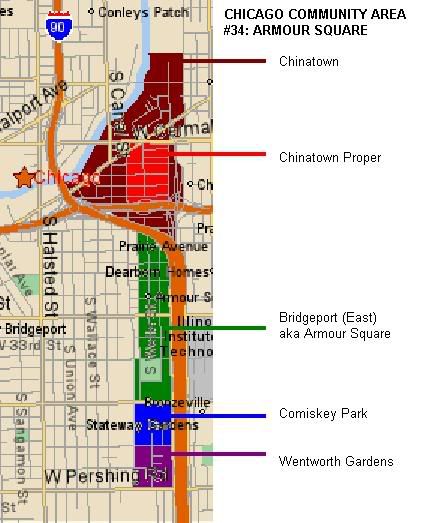Today's Adventure: Armour Square
CONCEPT
Assuming I'm not totally exhausted tomorrow, and most likely even in that case, I will be exploring Armour Square for my novel Euphemism.
Anyone who is interested may come along... just email me to set up a rendezvous. I expect to be headed out around 5 PM. If all goes well, I'll spend a few minutes at Comiskey and Wentworth Gardens, then pass through the eastern part of Bridgeport on the way to Chinatown. Chinatown will be the bulk of the evening.
Here's a Yahoo! map I tweaked, for those of you interested in the layout:

The following is excerpted from The Encyclopedia of Chicago edited by Grossman, Keating, and Reiff:
The Armour Square Community Area illustrates the difference between a neighborhood and a community area. This long thin area (an assemblage of leftovers from adjacent community areas, 21 blocks long, 4-5 blocks wide) is wedged between rail lines, expressways, and the South Branch of the Chicago River. It contains three distinct neighborhoods. African Americans dominate the population to the south; the middle section holds recently arrived Hispanics; and along with a few Italians and blacks, Chinatown fills the northern section.
Armour Square has been, from the beginning, principally a working-class area. Germans and Irish arrived during the Civil War, and later, Swedes joined the population. These groups used the area as a way station as they moved southward and climbed upward in social and econmomic status. Armour Square lay south of the burned area during the Chicago Fire of 1871 but was nonetheless greatly affected by the disaster. Laws enacted after the fire required brick or stone construction in the central city. The resulting increase in costs drove many working families out to the edge of the "brick area," and Armour Square received many such families. Armour Square subsequently lost blocks of housing as the tracks of bordering railroads were elevated. These changes cut off the area from neighborhoods to the east and west.
By 1899, Italian immigrants arrived and formed the Roman Catholic parish of Santa Maria Incoronata. Commercial operations began to displace housing in the area. Some of the encroaching businesses were extensions of the notorious Levee district just to the east. In 1909, Charles Comiskey built a new baseball park for the Chicago White Sox between 34th and 35th Streets. The old Sox park then became home to the American Giants of the Negro League. In 1991 the White Sox moved into a still newer stadium just south of the onld Comiskey Park; the Negro Leagues having long since vanished.
Around 1912, Chinese living in an enclave at the south edge of the Loop began a mass movement southward. The Chinese encountered severe racial discrimination, however, and were forced to do business through an intermediary. The H.O. Stone Company acted on behalf of 50 Chinese businessmen to secure 10-year leases on business in the new area. Chinatown became a major tourist attraction boasting an impressive entrance gate and many other distinguishing features.
As the city's "black belt" began to expand during World War I, African Americans moved into Armour Square's southern section, numbering about 4,000 by 1930. This figure remained stable through the Great Depression and World War II, until, in 1947, the Chicago Housing Authority completed Wentworth Gardens at 37th and Princeton, and the neighborhood reached an all-time high population of over 23,000 with blacks making up nearly half the total. Later, widespread demolition made way for construction of the Dan Ryan and Stevenson Expressways and their interconnecting ramps, which set off a continuing decline in population.
In 1999, the Chinese constituted over half the area's population. The Chinese were moving west into Bridgeport and a rejuvenated Chinatown continued as a major tourist attraction with many shops and famed restaurants. An outside investor from Hong Kong developed Appleville apartments, and a consotium of Chinese businessmen and local banks developed Chinatown Square and Jade City apartments. A new Chinatown Park was under construction along the river. Adaptive reuse of old structures, nearby infill housing, and the recently enlarged McCormick Place to the east added energy to the area. David M. Solzman pp. 39-40.
More information available upon request.
~ Connor

0 Comments:
Post a Comment
Subscribe to Post Comments [Atom]
<< Home